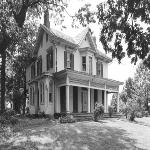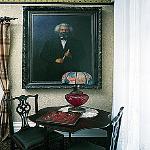16 August 2010

Photo: National Park Service
Cedar Hill, home of Frederick Douglass, in Washington, DC's Anacostia neighborhood, shown here in 1905.
The Anacostia neighborhood - named for the polluted branch of the Potomac River that runs past it - is the poorest, most run-down section of Washington, D.C.
It encompasses most of the city's public-housing projects and burned-out homes.But among them, in what had been Washington's first suburb, are some beautiful places and significant historical sites.

Library of Congress
Frederick Douglass, once an escaped slave, became one of the most riveting speakers against slavery in the South.One sits on a high spot called Cedar Hill, from which one gets a magnificent view of the distant U.S. Capitol, Library of Congress, and Supreme Court Building.
A small but elegant mansion was built there in 1852, when that part of Anacostia was for white Protestants only - no Catholics, Jews, or, certainly, African-Americans were welcome.
The owner got into financial trouble, and the property was taken over by an institution called the Freedman's Bank, which was set up after the Civil War to help former southern slaves.

Carol M. Highsmith
This is the parlor as Frederick Douglass kept it at Cedar Hill, restored by the National Park Service.And the Freedman's Bank sold Cedar Hill to a black man who broke the color line in Anacostia. He was the bank's own president, Frederick Douglass, an escaped slave who had become the most rapturous speaker in the abolitionist movement.
Douglass, who had learned to read from little white boys to whom he sneaked food when he was a slave, inspired other slaves to learn to read as the path to freedom and a full life.
His home in Anacostia contains hundreds of Douglass artifacts, including his walking sticks, swamp hats, and pens that he used to write his speeches and books in the little, windowless building called a growlery out back.

Library of Congress
Douglass is prominent on this 1881 lithograph, Heroes of the Colored Race. The others are U.S. senators Blanche Kelso Bruce (left) and Hiram Revels (right).The main house looks like a smaller version of his master's old manor home.
That's why he bought it, Frederick Douglass said. He couldn't pass up the opportunity because of the irony of it all.